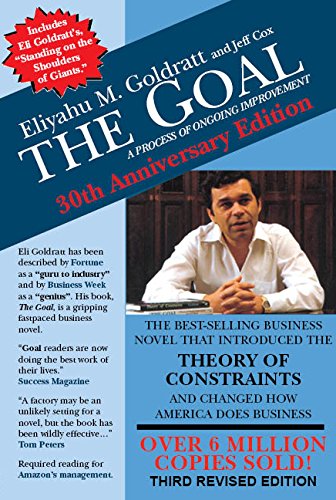Dr. Eli Goldratt (The Goal Author) – TOC – Self Learning Business Program
Original price was: $1,997.00.$77.00Current price is: $77.00.
Description
When I first encountered Dr. Eli Goldratt’s work, it was like a lightbulb moment. The man behind “The Goal,” Goldratt revolutionized how we think about business processes and constraints. His Theory of Constraints (TOC) isn’t just a concept; it’s a powerful tool that’s reshaped industries worldwide.
Diving into Goldratt’s Self Learning Business Program, I discovered a treasure trove of insights. It’s not just about identifying bottlenecks; it’s a comprehensive strategy for continuous improvement and achieving unparalleled success. Whether you’re a seasoned professional or just starting out, Goldratt’s teachings offer invaluable lessons in efficiency and effectiveness.
Exploring Dr. Eli Goldratt’s Work
When I first delved into Dr. Eli Goldratt’s theories, I was struck by the depth and practicality of his concepts. The Theory of Constraints (TOC), a cornerstone of his philosophy, revolutionized the way I thought about processes and efficiency within any system. His book, The Goal, isn’t just a guide; it’s a transformative tool that outlines how businesses can achieve their objectives by identifying and overcoming their primary constraints.
Goldratt’s work extends beyond traditional business contexts. Through his Self Learning Business Program, he introduced a structured way for individuals and organizations to continually improve by focusing on these constraints. This program integrates seamlessly with TOC, providing a comprehensive approach that can be applied to various industries from manufacturing to healthcare.
What made Goldratt’s teachings particularly resonant for me was the way he made complex concepts accessible. His focus on practical application rather than just theory opened my eyes to the possibilities of achieving greater efficiency and effectiveness in my professional journey.
Understanding the Theory of Constraints (TOC)
Dr. Eli Goldratt’s Theory of Constraints (TOC) fundamentally transformed how I, and many others, approach process improvements and efficiency. At its core, TOC is a methodology for identifying the most significant limiting factor (i.e., constraint) that stands in the way of achieving a goal and then systematically improving that constraint until it is no longer the limiting factor. Through my experience, what sets TOC apart is its laser-focus on the constraints that truly matter, rather than getting sidetracked by symptoms of these constraints.
Identify the Constraint: Determining the bottleneck in the process is the first step. It’s about pinpointing the one area that critically limits throughput.
Exploit the Constraint: Once identified, maximize the constraint’s efficiency without necessarily investing in expensive changes or upgrades.
Subordinate Everything Else: Adjust all other processes to support the improvement of the constraint. This often means making the throughput of the constraint the main priority.
Elevate the Constraint: If necessary, take actions to permanently increase the capacity of the constraint.
Repeat: After addressing a constraint, new limitations will eventually appear. Hence, the process of identifying and improving constraints is continuous.
Integrating the Theory of Constraints into daily operations has propelled numerous businesses towards achieving their objectives more efficiently. Whether it’s manufacturing, project management, or service industries, TOC offers a structured yet flexible approach for continuous improvement. Notably, applying TOC doesn’t require a complete overhaul but rather a strategic refinement of existing processes, making it a practical enhancement tool. The beauty of TOC lies in its simplicity and the profound impact it can have on productivity and growth.
The Power of Self Learning Business Program

In the dynamic world of business, the self-learning business program, inspired by Dr. Eli Goldratt’s Theory of Constraints (TOC), has revolutionized the way I and many others think about problem-solving and management. This approach doesn’t just suggest minor adjustments but encourages a deep jump into the core issues hindering growth. What’s standout about this method is its focus on empowering individuals to identify, tackle, and adapt to challenges autonomously.
Through the self-learning program, I’ve witnessed firsthand the transition of teams from being dependent on a top-down directive to becoming proactive problem solvers. The methodology fosters a culture of continuous improvement, where every team member becomes a crucial part of the solution-finding process. This isn’t about inundating staff with more information but rather refining their ability to pinpoint and exploit constraints effectively.
The structured yet flexible nature of the self-learning approach means it’s applicable across industries, from manufacturing to services, without necessitating a complete system overhaul. It also aligns perfectly with today’s rapid, ever-changing business world, where adaptability isn’t just an asset; it’s a necessity. By harnessing the principles of TOC within the self-learning framework, companies can achieve significant leaps in productivity and growth, ensuring they not only survive but thrive in competitive markets.
Implementing Goldratt’s Strategies

Implementing Dr. Eli Goldratt’s Theory of Constraints (TOC) within a self-learning business program isn’t as daunting as it might seem at first glance. I’ve found that the key lies in breaking down the process into manageable steps, focusing on identifying the system’s constraints, and devising solutions to address them directly. Here’s how I approach it:
First, I start by pinpointing the bottlenecks that are limiting our growth or efficiency. This step is critical because, as Goldratt emphasized, you can significantly enhance your system’s performance by optimizing a few critical points, rather than trying to fix everything at once.
Next, I focus on aligning the team’s efforts to address these bottlenecks. This often involves a mix of training, process adjustments, and sometimes, technological solutions. The beauty of the TOC lies in its versatility – it’s applicable in manufacturing, healthcare, IT, and virtually any other industry.
Finally, I ensure that the solutions are embedded within a self-learning framework. This allows my team to continuously identify and solve new constraints as they emerge, without needing a complete overhaul each time. It’s a powerful way to foster a culture of continuous improvement and innovative problem-solving.
By integrating TOC into our business processes, we’re not just solving problems; we’re transforming our entire approach to management and efficiency.
Unlocking Success with TOC
In my journey to understand and carry out the Theory of Constraints (TOC) within various business models, I’ve discovered its undeniable power to transform operations and enhance productivity. Dr. Eli Goldratt’s TOC, as illustrated in his seminal work, The Goal, provides a robust framework for identifying and overcoming the bottlenecks that hinder business growth. Implementing TOC isn’t just about solving temporary issues; it’s about fostering a culture of continuous improvement and self-learning within an organization.
TOC stands out by emphasizing the importance of Systemic Thinking. It’s not enough to tackle problems as they arise; it’s critical to anticipate them by understanding the entire system. This approach has helped me guide businesses toward pinpointing their most significant constraints and addressing them in a manner that’s both effective and sustainable.
One of the key steps in applying TOC is the Five Focusing Steps, a methodology designed to continuously identify and resolve constraints. These steps have been my roadmap in advising organizations on how to streamline their processes and significantly improve their throughput. The beauty of TOC lies in its simplicity and its power to bring about dramatic changes in performance by making minimal but strategic adjustments.
Through applying TOC, I’ve witnessed firsthand how businesses across industries have not only overcome their immediate challenges but have also equipped themselves for future obstacles, ensuring long-term success and resilience.
Conclusion
Dr. Eli Goldratt’s Theory of Constraints (TOC) is more than just a business tool; it’s a mindset that can revolutionize how we approach challenges and opportunities alike. By focusing on systemic thinking and the Five Focusing Steps, we’re not just solving problems—we’re transforming our entire approach to business. It’s clear that TOC isn’t just about overcoming the hurdles of today. It’s about equipping ourselves with the knowledge and skills to navigate the complexities of tomorrow. As we continue to carry out these principles, we’ll see not just growth but true evolution in our businesses. Let’s embrace TOC and unlock our full potential.
Frequently Asked Questions
What is the Theory of Constraints (TOC)?
The Theory of Constraints (TOC) is a management philosophy developed by Dr. Eli Goldratt that identifies the most significant limiting factor (i.e., constraint) that stands in the way of achieving a goal and systematically improves that constraint until it is no longer the limiting factor.
How does TOC help businesses?
TOC helps businesses by providing a framework to identify and overcome their most critical constraints. This leads to improved efficiency, higher output, and increased profitability by focusing resources on the most impactful areas.
What is Systemic Thinking in the context of TOC?
Systemic Thinking is an approach within TOC that emphasizes understanding the entire system, rather than individual components, to better identify constraints and implement effective solutions.
Can you explain the Five Focusing Steps?
The Five Focusing Steps are a core component of TOC used to address constraints: 1) Identify the constraint, 2) Exploit the constraint, 3) Subordinate everything else to the decision, 4) Elevate the system’s constraint, and 5) Prevent inertia by going back to step 1 if the constraint is broken.
How does TOC prepare businesses for future challenges?
By adopting the principles of TOC and focusing on continuous improvement, businesses can develop a more agile approach to problem-solving and decision-making. This prepares them to effectively address future constraints and maintain long-term resilience and success.




